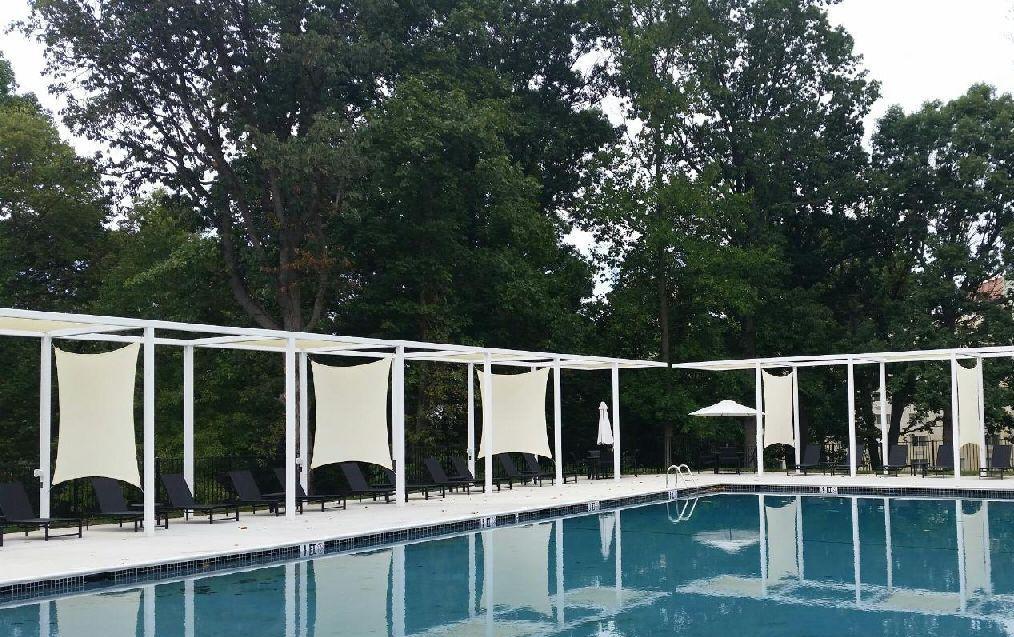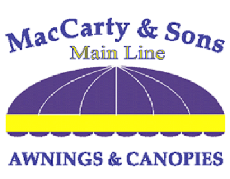
Fabric shades are in, outside
From Fabric Architecture | January 2015
By Barb Ernster
Screens and shades that protect from sun, wind and insects bring indoor comforts to outdoor living.
Outdoor living is a growing trend for homeowners seeking to relax and entertain outside with all the comforts of indoor living. Restaurants and hotels are also extending guest areas to outdoor patios, sidewalks, rooftops and beachfronts. All of this is feeding the market for screen and shade products that keep out the heat, UV rays, rain, wind and bugs, and offer comfortable conditions day or night.
Interior roller shades with solar screens are selling across commercial and residential markets, with each market receiving 50 percent of the total volume, says Jules Duguay, president of Mermet Corp. in Cowpens, S.C. “In the residential market, sales are driven from Internet retailers, mass merchants, traditional dealer networks and high-end channels with high rates of motorization and lighting control system integration. The advancement of wireless, total home management systems that control shades, lighting, HVAC and security systems is driving this sector.”
Going all out
Many interior window-covering fabricators have added exterior systems to their offerings as they seek more revenue opportunities. The same is happening for traditional awning fabricators with interior and exterior roller shades. SW Sun Control Products Inc., Tucson, Ariz., manufactures retractable awnings, but is focusing more on retractable screens and exterior shades. Plenty of options to fit different styles and functions is adding to their popularity, says Ian Meuschke, owner.
Exterior shades provide better sun protection and energy savings than interior shades because they block the heat outside before it hits the window glass or building structure. This is a big selling point for homeowners, says Stefan Poetsch of Rollac Shutter of Texas Inc., Pearland, Texas. “Solar protection is a great need. Just the simple fact that you can’t use an exterior space because the sun is too intense is driving the market. Strength and durability are an important issue, and exterior shading products need to be reinforced so they don’t flap around in inclement weather.”
Rollac’s Zipshades® come in sizes up to 20 feet wide and 20 feet tall, with larger sizes possible. They provide comfort and security, while maintaining a favorite view from a patio or window. The fabric is locked into place in a cast aluminum channel, providing a taut, clean look and wind stability, withstanding at least 40 mph winds as a free standing application.
Sunair® Awnings and Solar Screens in Jessup, Md., is experiencing new growth in exterior solar shades and zipper screens. Although the majority of its sales still come from patio and deck awnings, exterior sun screens are increasing faster than other products, says Robert Martensson, owner and president. The company also produces interior roller shades to complement its line.
“I think a lot of dealers can say they sell the same amount of retractable awnings from year to year, but business is growing because of the screens. There is much more interest among homeowners to save energy,” he says. “Today we feel it’s important that an awning company have the ability to offer all three products—awnings, exterior screens and interior shades—rather than walk away from a sale if one product is a bad fit for the homeowner.”
Exterior zipper screens with mesh or windows are becoming popular to enclose porches and verandas. Retractable pergola roof awnings are also getting some traction, drawing attention from the hospitality industry and homeowners. Combined with zip screens, pergolas can convert a patio into an enclosed dining or meeting room.
The retractable expansion
“We are going to see exponential growth in retractable vertical screens,” says Meuschke. “In the hospitality industry, where creating amazing outdoor environments means growing profits, the opportunities are endless.”
Sunmaster of Naples Inc., Naples, Fla., is seeing its business trend toward retractable screens and awnings, as well as hurricane shutters for residential and commercial customers, although its bread and butter business is still custom awnings, according to Jeff Barkin, marketing manager. The company’s Titan Screens™ line is popular with restaurants seeking to expand their outdoor space and wanting sun protection and bug control.
Residential customers are also replacing screen cages around their pools and patios with retractable screens. In the event of a hurricane, insurance companies will not insure cages, which can cost $60,000 or more to replace. Retractable screens can be drawn in and stored with the push of a button if a storm is coming.
Barkin says the popularity of retractable screens is extending farther north to customers seeking protection more from insects than from the sun. In the Upper Midwest, people want to extend their time outdoors but can be driven indoors by mosquitoes and gnats. In the Northeast, black flies are a huge problem. “We’re starting to get calls from all over, even places that we didn’t put much effort into, so I’m assuming it’s becoming more common and people are seeing them more in homes and restaurants.”
The growing ability to have retractable shading systems deploy automatically without flipping a switch or pressing a button is leading the growth in motorized exterior shading. “The technology in our industry is beginning to catch up to other technologies,” says Meuschke.
Advances in fabric
Besides automation technologies, shade fabric manufacturers are innovating with new fiber technologies and more high-performance raw materials and fabric constructions. Advancements in fabric manufacturing equipment are also contributing to the performance gains, says Duguay.
Many fabric choices are available for roller shades. Solar screen fabrics (woven PVC-coated fiberglass and polyester), popular on both coasts, provide clear views and varying levels of solar and glare control. Blackout fabrics are growing in popularity and feature 100 percent UV protection, heat management and complete privacy. There are also more requests for decorative fabrics, which offer unique color, style and textures.
Most exterior shade and screen fabrics have an openness value of 5–12 percent, providing options for the amount of light and visibility to allow. Some fabrics come in weaves as tight as 99 percent with a 1 percent openness factor for areas with intense heat.
“Screen fabric performance is becoming more scrutinized from the homeowner to the 100-story building architect,” says Duguay. “Demands for new levels of sustainability, heat management and natural daylighting with glare control have never been stronger. In the past, the focus was solely on openness factor, but the focus now includes visible light transmission (Tv) levels, or glare control, and solar radiation reflection (Rs), or heat reflection levels.”
Options meet demand
Mermet recently added two fabrics to its high-performance product offering. T Screen with KOOLBLACK™ technology is a dual-colored screen fabric with glare control and energy-saving features. While standard dark-colored fabrics naturally control glare, they also absorb solar radiation, which contributes to heat gain in a building. The patented technology creates heat reflection properties in dark-colored fabrics and is infused with light-colored fabric for its natural heat-reflection properties. GreenScreen® Evolve™ is a zero-waste fabric produced from recycled water bottles and has received a Cradle-to-Cradle Certified™ Silver level. It is available in 1,3, 5 and 10 percent openness factors in nine designer colors.
Twitchell Corp., Dothan, Ala., is seeing more requests for shade sails, canopies and outdoor roller shades. “More customers are looking to shade in much larger areas, but they’re also looking for beauty and maintenance freedom,” says Jeff Frobrose, business manager.
Twitchell has developed a new Textilene® nano™ 95 fabric to meet the demand for lighter and more ornate screening fabrics. Its thin profile and light weight require a smaller storage cavity for retractable systems, and create a smooth transition from indoor living spaces to outdoor.
The company also introduced a new Omega Tex hurricane screen that uses a ballistic-grade aramid yarn in a fabric that has passed the Dade County hurricane impact test. Unlike other hurricane systems made for use only in the event of a hurricane, Omega Tex screens have a design quality that allows customers to use the product year round. In many cases, they will use it to screen in their entire outdoor living space, says Frobrose.
Recasens USA, Blue Bell, Pa., distributes solar protection fabrics, including solution-dyed acrylic and vinyl-coated polyester solar screen fabrics made by its parent company in Barcelona, Spain. The fabric’s dimensional stability is important for large screens and zippered screen applications, in particular. A precise combination of quality core yarns, precision yarn coating, well-controlled weaving, and the proper heat setting is required to provide a high level of sun control, visibility and dimensional stability at the same time, says Doug Dubay, national sales manager. Zipper screens have a coil zipper welded onto both edges of the retractable screen. The zipper is then inserted into a side retention rail on both sides of the screen. This, along with a roller tube on top and hem bar on the bottom, holds the screens securely in place.
Recasens’ RecScreen 4000P is a PVC/polyester screen fabric with a 99 percent shade factor and high visibility. Because of its dimensional stability, RecScreen 4000P is widely used in Europe for drop-arm awning applications, in addition to traditional solar screens, says Dubay. Consumers prefer the darker colors—black, bronze or bronze tweed—because of the ability to see through the fabric from the inside looking out.
With a 95 percent shade factor, the RecScreen 5000P is used in mid-to-northern areas of the country where many people don’t have air conditioning, so screens reduce the heat gain in the daytime and allow the cooler air in at night while keeping bugs out.
“Products that reduce solar heat gain and protect from inclement weather is where the market is going,” says Martensson. “Everyone wants to save money on their utility bills, create a comfortable indoor/outdoor sitting area, or they want to be able to see in and out of the window without glare. That’s the beauty of a rolling solar shade.”
Barb Ernster is a freelance writer based in Fridley, Minn.
Serving Bucks County, Chester County, Delaware County, and Montgomery County.
© 2025 Web Design & Development time4design - Montgomery County Web Design.







